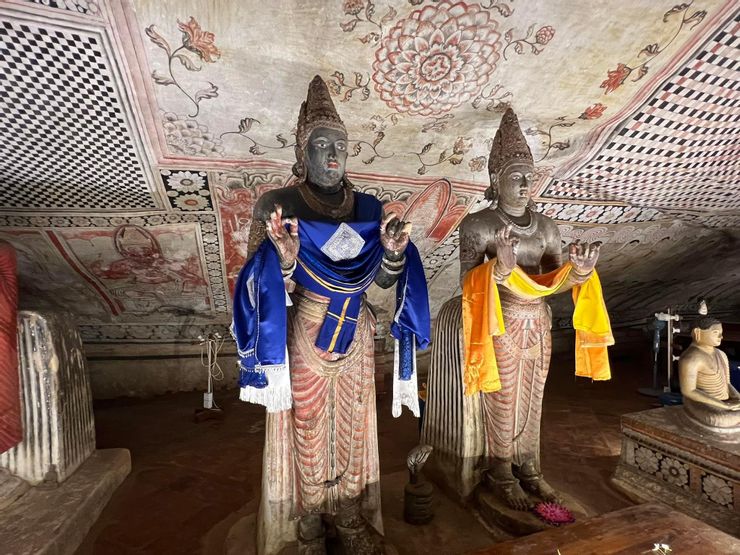Sri Lanka is known for its rich cultural heritage, particularly its temples, which are closely tied to the country’s ecosystems. Temples often serve as both spiritual centers and guardians of nature, reflecting the symbiotic relationship between culture and the environment in Sri Lanka.
The Temple of the Tooth Relic, also known as Sri Dalada Maligawa, located in Kandy, is one of the most revered Buddhist temples in Sri Lanka. It houses a tooth relic of the Buddha and is a UNESCO World Heritage Site. The temple is situated near Kandy Lake, a natural body of water that supports a rich ecosystem with various birds and plants.
Anuradhapura, the ancient capital of Sri Lanka, is home to numerous significant temples and stupas, including the sacred Sri Maha Bodhi tree, which is believed to be a descendant of the tree under which the Buddha attained enlightenment. The area is surrounded by forests and irrigation tanks, with a well-preserved ecosystem that has been maintained for centuries.
Many temples in Sri Lanka are located within forest reserves, creating a peaceful atmosphere where the environment and spirituality intertwine. For instance, the Dambulla Cave Temple is located in a rocky area surrounded by forested hills and a diverse range of plant and animal life. The temple complex, which includes cave shrines and murals, is not only a spiritual site but also a key part of Sri Lanka’s natural heritage.
Sri Lanka’s temples and ecosystems are deeply connected. The preservation of natural landscapes around temples is often seen as an extension of religious practice, where nature is respected as sacred. This symbiotic relationship continues to foster biodiversity and cultural preservation in the country.
Sri Lanka’s ecosystems are incredibly diverse, shaped by the island’s unique geography and tropical climate. The country boasts a variety of habitats, from lush rainforests and dry zone forests to wetlands and coastal ecosystems, each supporting a wide range of flora and fauna. These ecosystems are not only critical for biodiversity but also provide essential services like water purification, carbon storage, and climate regulation.
One of the most significant ecosystems in Sri Lanka is its rainforests, particularly those in the southwestern region of the island. These forests are home to many endemic species, including the Sri Lankan leopard, purple-faced langur, and a rich variety of birds and insects. Key conservation areas like the Sinharaja Forest Reserve—a UNESCO World Heritage Site—are vital for maintaining the biodiversity of these rainforests. Sinharaja is known for its dense canopy, rare plant species, and as a habitat for the endangered Sri Lanka blue magpie.
The dry zone forests in the northern and eastern parts of the island, such as those in Wilpattu National Park, provide a different set of ecological services. These forests are home to Sri Lanka’s iconic elephants, leopards, and a range of bird species, and they are vital for the country’s water systems. Many of these ecosystems are interspersed with ancient reservoirs and tanks that are part of Sri Lanka’s traditional irrigation systems, which have been in use for over two millennia.
Sri Lanka is also renowned for its coastal and marine ecosystems, which include coral reefs, mangroves, and seagrass beds. The country’s coral reefs, like those in the Hikkaduwa National Park, are home to a wide range of marine life, including sea turtles, fish, and various species of coral. Mangrove forests along the coastlines help protect the shore from erosion, provide habitats for numerous species, and act as nurseries for marine life. The Puttalam Lagoon is a notable example of a coastal ecosystem that supports both local fishing communities and a rich variety of wildlife.
Wetlands, such as the Bundala National Park and Koggala Lagoon, are another important ecosystem in Sri Lanka. These areas are crucial for migratory birds, with Bundala serving as a key stopover for birds along the East Asia-Australasia flyway. Wetlands also play an essential role in water filtration, flood control, and supporting biodiversity.
Finally, grasslands and savannahs in central Sri Lanka, such as in the Horton Plains National Park, provide habitats for species like the sambar deer and the endemic Sri Lankan leopard. These ecosystems are vital for maintaining the health of the island’s overall biodiversity, providing both shelter and food sources for a variety of wildlife.
Sri Lanka’s ecosystems are intricately linked with its cultural practices, including the temple environment. Many sacred sites, such as those surrounding temples in forests or along riverbanks, also serve as protected areas, ensuring the continued health of both the environment and local communities. The preservation of these ecosystems is crucial, not just for the country’s wildlife, but also for maintaining the cultural and spiritual practices that have been intertwined with the natural world for centuries.
